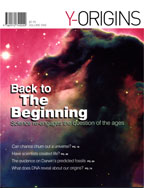THE PROBLEM WITH HALF AN EYE
Was Darwin Right About the Eye?
Looking down at Greenland from 32,000 feet on my trip from Rome to Seattle, I heard a strange noise in the aircraft that sent my blood pressure soaring into hyperspace. Suddenly I began to wonder what would happen if one tiny part on the enormous Boeing 747 failed. Engines, hydraulics, air pressurization—all were complex systems that worked only when several interdependent parts functioned properly.
In vain I sought comfort in my airline pretzels, but comfort can never be found in low-fat foods. I kept thinking of all those dedicated employees (excuse me: “members of the Boeing family”) shown on the commercials who apparently love nothing more in life than a well-oiled 747 and who perpetually ponder my safety. But the nagging thought still popped into my head: “Just one faulty or missing part and I’d become part of the first bomb ever to be dropped on Greenland.”
In one sense, biological systems are like my Boeing 747: one missing or defective part and they won’t work. Here lies one of the major unanswered problems of biology. How did highly complex, interdependent biological systems like the eye develop slowly over eons of time? They would never have worked until fully developed.
Let’s step back for a minute and think about all this.
Airplanes, automobiles, cell phones, computers, and other complex machines, can always be traced back to a designer. However, with biological systems, materialists (those who believe nothing exists outside of the material world) assume there is some natural process that created such systems.
The real issue here is whether or not a designer is behind such complexity. There are four possibilities:
1. A designer created biological complexity supernaturally
2. A designer created biological complexity through natural processes
3. A designer combined natural processes and supernatural means to create biological complexity
4. A designer doesn’t exist. Complexity came about naturally.
Materialists believe the latter. Scientists who advocate intelligent design generally agree that some super-intelligence is behind it all, even though they leave the nature of a designer to theologians.
Here we must look at the evidence to see which of the possibilities makes the most sense. To determine the best option, we need to look closer at complex biological systems to determine whether they can be explained by natural causes alone.
Endnotes | Next
|




